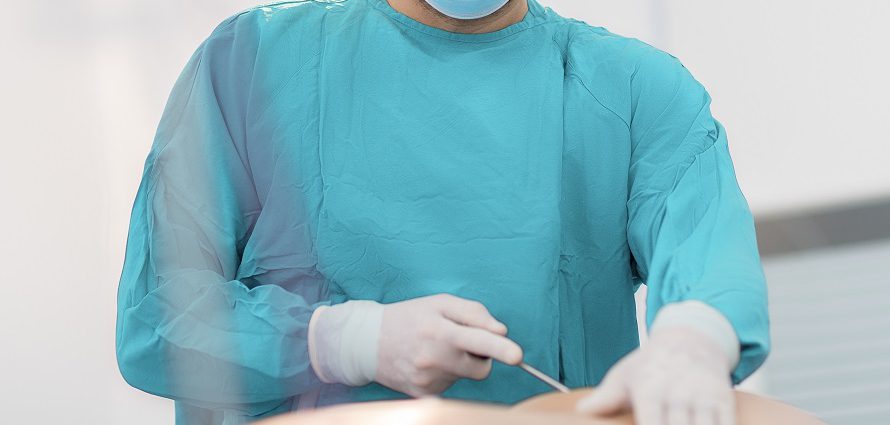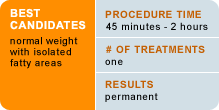Liposuction Surgery – Types, Costs and Risks
Medically Reviewed by: Dr. John Kim

Reviewed by Peter Fodor, MD, FACS

Liposuction, also known as lipoplasty, is a commonly performed cosmetic plastic surgery procedure that can reduce the appearance of unsightly bulges and help you attain a slim, svelte physique. It is frequently performed on the abdomen, back and buttocks, but the technique can also be used on the thighs, knees, calves, upper arms, face, neck and other body areas.
If you have been dieting and working out but cannot get rid of that persistent muffin top, those unattractive love handles or that embarrassing arm or neck flab, liposuction may be the solution.
Liposuction procedures can be performed on their own or in combination with other procedures, such as facelift, breast reduction and tummy tuck. In fact, liposuction is often part of a combination procedure known as mommy makeover, which typically also includes breast lift and tummy tuck, and is designed to help mothers regain their pre-pregnancy body shapes.
Liposuction Candidacy
Contrary to popular belief, liposuction is not a weight loss procedure. The ideal candidate for liposuction is a healthy adult who is close to his or her ideal weight but is troubled by stubborn pockets of fat that fail to respond to diet and exercise.
If you are considering liposuction, the first step is to become as educated as possible about the procedure. Next, schedule a consultation with a board-certified plastic surgeon with extensive experience performing liposuction. Be sure to choose a surgeon certified by the American Board of Plastic Surgery, as this level of certification ensures that the surgeon has undergone extensive training and is highly esteemed by his or her colleagues.
At your initial consultation, your surgeon will examine your problem areas and discuss your goals. Be honest about your health conditions and about what you hope to achieve from surgery. The surgeon will then explain the different types, costs and potential risks of liposuction. He or she may also discuss liposuction clinical trials for which you might qualify.
If your surgeon deems you a candidate for liposuction, the next step will be to schedule your surgery.
How Liposuction Is Performed
Step One: Marking your territory. Using a magic marker, your surgeon will literally mark the areas of your body where he or she will remove unwanted fat.
Step Two: Anesthesia. Liposuction is typically performed under general anesthesia, but in some cases local anesthesia may be used. Other options include intravenous sedation or epidural block. The decision involves both you and your doctor and should take into account the nature and extent of the liposuction.
Step Three: Wetting solution. Wetting solutions are used to minimize blood loss and increase the safety of liposuction. They are infused into the area before fat is removed. The fluid contains saline (salt water), epinephrine (which constricts blood vessels to minimize any blood loss) and a local anesthetic.
Various types of wetting solutions are used in liposuction. The main difference between them is the amount of fluid used.
- The “dry” technique. Before wetting solutions came along, surgeons went in dry. This resulted in blood loss and bruising. In fact, about 45 percent of what was suctioned out was blood (not fat), so the dry technique has fallen out of favor.
- The “wet” technique. This technique involves the infusion of 100 to 300 milliliters of fluid (with or without epinephrine) into each treatment site. With the wet technique, 20 to 25 percent of what is suctioned out is blood.
- The “super-wet” technique. The super-wet technique involves the infusion of greater amounts of fluid than with the wet technique. It involves a 1:1 or 1:1.5 ratio, which means that the amount of fluid is approximately equal to the amount of fat to be removed. Less than 1 percent of what is suctioned out is blood with this technique.
- The tumescent technique. This involves even more fluid than is used in the super-wet technique. The surgeon will infuse three to six times as much fluid as the volume of the aspirate (fat, fluid and blood content) to be removed. Proponents say the tumescent technique swells the tissues, which aids in fat removal; but detractors say it interferes with the surgeon’s ability to sculpt. Opponents also claim the technique is unsafe because of potential fluid overload and an overdose of anesthetic.
What Is a Cannula?
A cannula is a long, hollow instrument that is connected to the fat-suctioning device used during liposuction. When inserted through incisions in the skin, it enables the plastic surgeon to suction out the fat.
Today, cannulas are about 3 millimeters or finer in diameter. In the past, cannulas were as large as 10 to 12 millimeters in diameter. The smaller diameter means less trauma to surrounding tissues and blood vessels.
Step Four: Fat removal. There are many different ways to vacuum out the fat during liposuction.
- Traditional suction-assisted liposuction.This involves inserting a cannula (a long, thin tube) through a tiny incision to vacuum the fat cells. The surgeon moves the cannula back and forth through the fat layer to break up, and then suction out, the excess fat.
- Ultrasound-assisted liposuction. During this procedure the surgeon inserts a special cannula through small “access” incisions. The cannula emits sound waves to help break up the fat, making it easier to vacuum. Vaser-assisted liposuction is the third-generation version of ultrasound assisted liposuction technology. The cannula used for Vaser-assisted liposuction emits gentler sound waves to break up and then remove fat.
- Power-assisted liposuction. This procedure uses a motorized cannula to break up fatty tissue that will then be vacuumed out. It is inserted through tiny incisions.
- Laser-assisted liposuction. This involves a small incision and the insertion of a laser fiber probe that produces a burst of energy to liquefy the fat before it is removed. (Two of the brand names you may have heard about are SmartLipo and CoolLipo.) Proponents say that laser liposuction is the latest and greatest and may also tighten skin. But detractors say it adds nothing to the results of liposuction except for expense.
- Body-jet liposuction. Using a thin, fan-shaped jet that pulsates water, your surgeon loosens fat cells from connective tissue while simultaneously vacuuming them out. It is sometimes called water-jet assisted liposuction or water-assisted liposuction. Other liposuction techniques destroy or break apart the fat cells before suctioning them out of the body, but the water-assisted technique may loosen them first. As a result, water-assisted liposuction may be less traumatic than traditional liposuction methods.
Putting It All Together
Based on your surgeon’s experience and expertise and your particular case, he or she will choose the appropriate anesthetic, wetting solution and liposuction technique.
The time in surgery varies, depending on the size of the area being treated. It can span from 30 minutes to five hours. If you choose to have multiple areas treated at once, the procedure will take longer.
The Liposuction Procedure
Prior to surgery, your surgeon will draw on your body using a marker to map out the areas to be treated. Next, you will be asked to lie on an operating table, and anesthesia will be administered. Liposuction is typically performed using general anesthesia, conscious sedation or local anesthesia.
Your surgeon will then inject a wetting solution consisting of saline, epinephrine and a local anesthetic into the treatment areas. Saline is a mixture of salt and water that helps to soften up the fat for easier removal. Epinephrine constricts blood vessels to prevent bleeding, while local anesthetic helps to numb the area and increase your comfort.
Next, your surgeon will make small incisions in your skin and insert a narrow tube known as a cannula. By moving the tube back and forth, your surgeon will dislodge, break up and suction fat from beneath your skin.
Cost of Liposuction
The cost of liposuction depends on several factors, including the number of body areas to be treated, the type of procedure chosen and the experience of the surgeon. As with any plastic surgery procedure, the main costs of liposuction are the surgeon’s fee, the anesthesia fee and the facility (operating room) fee. The surgeon’s fee can range from $2,000 to $4,000, while the anesthesia and facility fees together can run $1,200 to $1,500.
Be sure to get an estimate of the total liposuction cost, including the cost of medications and bandages, prior to scheduling surgery.
Liposuction Risks
All surgeries carry risks, including liposuction. Liposuction risks include anesthesia complications, infection and bleeding.
Many risks associated with liposuction can be minimized by taking precautions before and after surgery. For example, if you are a smoker, your surgeon will ask you to quit smoking before and after surgery to ensure that your incisions heal properly. In addition, avoiding aspirin and other nonsteroidal anti-inflammatory drugs can help minimize the risk of bleeding during and after surgery.
Your surgeon will explain all the liposuction risks and how to minimize them during your presurgery consultations.
Liposuction Recovery
The length and comfort level of your recovery from liposuction will depend on several variables, including the number of treatment areas and their size, your general health, and whether your lipo was performed on its own or in combination with other procedures. Be sure to follow all of your surgeon’s postoperative directions to ensure a smooth liposuction recovery with the best possible aesthetic results.
For more information about liposuction, visit our gallery of liposuction before and after photos and find a surgeon in our network of board-certified plastic surgeons.
About the Reviewer
John Kim, MD, is a board-certified plastic surgeon who is Clinical Director of Plastic Surgery at the Northwestern University Feinberg School of Medicine. Dr. Kim has published more than 50 articles and chapters regarding plastic surgery; has had his work featured by ABC News and the Chicago Sun Times, among other; holds several medical device patents; and sits on the editorial board of the Annals of Plastic Surgery, as well as many American Society of Plastic Surgeons committees. www.drkimsurgery.com



